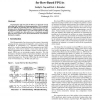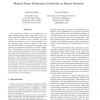756 search results - page 6 / 152 » Performance prediction based on inherent program similarity |
CEC
2009
IEEE
13 years 10 months ago
2009
IEEE
—When performing predictive data mining, the use of ensembles is known to increase prediction accuracy, compared to single models. To obtain this higher accuracy, ensembles shoul...
DAC
1994
ACM
13 years 11 months ago
1994
ACM
Sequential place and route tools for FPGAs are inherently weak at addressing both wirability and timing optimizations. This is primarily due to the difficulty in predicting these ...
OOPSLA
2010
Springer
13 years 5 months ago
2010
Springer
Accurately predicting program behaviors (e.g., locality, dependency, method calling frequency) is fundamental for program optimizations and runtime adaptations. Despite decades of...
BMCBI
2005
13 years 7 months ago
2005
Background: A new algorithm for assessing similarity between primer and template has been developed based on the hypothesis that annealing of primer to template is an information ...
CCGRID
2004
IEEE
13 years 11 months ago
2004
IEEE
The performance skeleton of an application is a short running program whose performance in any scenario reflects the performance of the application it represents. Such a skeleton ...




